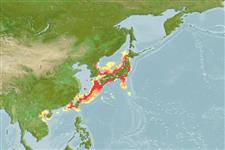Teleostei (teleosts) >
Albuliformes (Bonefishes) >
Albulidae (Bonefishes) > Pterothrissinae
Etymology: Pterothrissus: Greek,pteron = wing, fin + Greek, thrissa, -es = shad (Ref. 45335).
More on author: Hilgendorf.
Environment: milieu / climate zone / depth range / distribution range
Ecology
Marine; benthopelagic; depth range 147 - 1000 m (Ref. 50610). Temperate; 49°N - 15°N, 105°E - 149°E
Northwest Pacific: Japan (Ref. 559), China (Ref. 47439) and Russia (56557).
Size / Weight / Age
Maturity: Lm ? range ? - ? cm
Max length : 50.0 cm TL male/unsexed; (Ref. 56557)
Dorsal
spines
(total): 0;
Dorsal
soft rays
(total): 54-65;
Anal
spines: 0;
Anal
soft rays: 10 - 13;
Vertebrae: 105 - 107. This species is distinguished by the following set of characters (holotype measurements in parentheses): supraneural bones 6-7; dorsal-fin rays 54-65 (mode 58); total vertebrae 105-107 (107); pored lateral-line scales 99-109 (105); pre-dorsal scale rows 13-20 (16); head length 23-31 % (mean 27 %) of SL; pectoral-fin length 10-18 % (15 %) of SL; pre-dorsal-fin length 31-39 % (35 %) of SL; dorsal-fin base length 47-56 % (52 %) of SL; postorbital length 9-12 % (10 %) of SL; upper caudal-fin length 16-32 % (21 %) of SL (Ref. 109573).
Found in deep waters.
Life cycle and mating behavior
Maturity | Reproduction | Spawning | Eggs | Fecundity | Larvae
Spawning occurs in open waters. Eggs are pelagic (Ref. 205).
Masuda, H., K. Amaoka, C. Araga, T. Uyeno and T. Yoshino, 1984. The fishes of the Japanese Archipelago. Vol. 1. Tokai University Press, Tokyo, Japan. 437 p. (text). (Ref. 559)
IUCN Red List Status (Ref. 130435)
Threat to humans
Harmless
Human uses
More information
ReferencesAquacultureAquaculture profileStrainsGeneticsElectrophoresesHeritabilityDiseasesProcessingNutrientsMass conversion
Tools
Special reports
Download XML
Internet sources
Estimates based on models
Preferred temperature (Ref.
123201): 0.6 - 13.8, mean 8.6 °C (based on 65 cells).
Phylogenetic diversity index (Ref.
82804): PD
50 = 1.0002 [Uniqueness, from 0.5 = low to 2.0 = high].
Bayesian length-weight: a=0.01122 (0.00514 - 0.02450), b=3.04 (2.87 - 3.21), in cm total length, based on all LWR estimates for this body shape (Ref.
93245).
Trophic level (Ref.
69278): 3.3 ±0.2 se; based on diet studies.
Resilience (Ref.
120179): Medium, minimum population doubling time 1.4 - 4.4 years (Preliminary K or Fecundity.).
Fishing Vulnerability (Ref.
59153): Moderate vulnerability (40 of 100).
